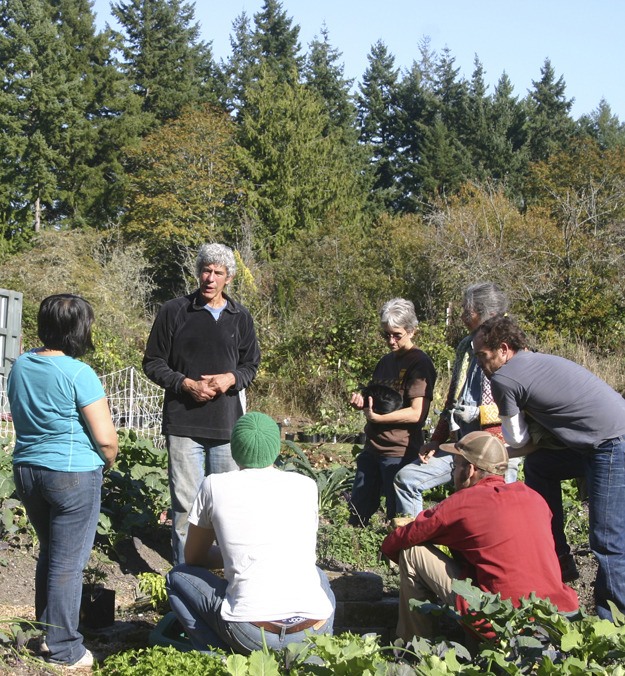Bees have a public relations problem. Despite all the benefit they provide – namely pollinating the food needed for our survival – some people just can’t get past their fear of them.
Bainbridge Island resident Chuck Estin, who taught a Natural Beekeeping class at Bay Hay & Feed last weekend, can relate.
Estin teaches something called permaculture which, like the humble bee, is often misunderstood.
“Permaculture is a way to create healthy communities of people, plants and animals,” Estin said.
As benign as that sounds, permaculture calls for a different way of interacting with the natural world.
“Anytime you offer an alternative to conventional thinking, it will attract rebels,” said Estin, who has a Ph.D. in molecular biology from Dartmouth.
The term “permaculture,” coined by Aussie Bill Mollison in the 1970s, has a bit of a counter-culture reputation, attracting a following of tie-dyed, dreadlocked idealists.
Like bamboo, permaculture has spread across the U.S. mostly “underground” via mentored hands-on training known as the Permaculture Design Course. In the last decade however, as the sustainability movement has gone mainstream, these courses have been popping up as if out of nowhere.
Bainbridge has one, in fact. Led by Estin, founder of the Old Mill Permaculture Center, the three-week intensive course did indeed draw its share of young environmentalists. But among the dreadlocks were a few gray hairs.
“The kids and us three old ladies,” joked Annette Klapstein, who took the course along with two other residents of Winslow Co-Housing.
Klapstein has always been an avid gardener. She likes to keep her hands in the dirt, growing vegetables in Co-Housing’s organic community garden. She’d read about permaculture, but had never had the opportunity to take a hands-on course.
The term initially combined the words “permanent” and “agriculture,” and most people in the U.S. associate permaculture with a kind of gardening method. The core philosophy, drawn from traditional and indigenous cultures around the world, is known as care and share: caring for the earth, caring for people and fair sharing.
The ethics, principles and tools of permaculture can be applied to any design challenge, whether it’s making a house, throwing a party or creating a community.
In fact, Estin models the principles in how the course itself is designed.
For instance, use and value diversity is one permaculture principle. So instead of setting himself up as the sole authority, the one voice, Estin enlisted the participation of 10 different islanders to help weave in pieces of the curriculum.
“It’s all about community,” said Estin, who, along with his wife Judy, has lived on Bainbridge for 26 years harvesting food from more than 30 fruit trees, chickens and vegetable beds.
Max Sassenfeld, of Tani Creek Farms, explored questions about how to manage large-scale food production. Olaf Ribiero shared his perspective on the importance of trees. Forest Shomer talked about saving seeds from the garden.
Intern Jesse Olian (yes, in dreadlocks) found the Old Mill Permaculture Center on the national database World-Wide Opportunities on Organic Farms website (www.wwoof.org). He met Estin along with a few other interested students and the mix seemed to fit. Olian and others work the garden in exchange for room, board and a set of whole life skills.
To demonstrate “learn by doing” and “observe and interact,” Estin’s course posed provocative open-ended questions each day. What is our relationship to native ecosystems? How can we shelter ourselves sustainably? How can we create more sustainable social systems?
With the mainstream culture turning green, permaculture is losing its fringe reputation. Many of the concepts of permaculture have morphed into the Transition Town movement, Estin said.
Those components are already in place on the island, most under the umbrella of Sustainable Bainbridge. SB’s Zero Waste program exemplifies the “Produce no waste” permaculture principle. Other organizations, including Friends of the Farms, Squeaky Wheels and Bainbridge Island Land Trust, all illustrate permaculture principles.
Kat Gjovik of Sustainable Bainbridge said the organization is beginning a conversation about “time banks.” Inspired by the flagship Hour Exchange in Portland, Me., several citizens will help explore how this or another similar program might work on Bainbridge Island.
In Portland, for example, community members deposit hours they work (an hour of plumbing, child care or sailing) and can withdraw hours for services offered by others.
Estin demonstrates his belief in a gift-based economy (sharing) through his permaculture practice. Last year he offered six free permaculture seminars at Real Foods on Winslow Way.
This year, he’s collaborating with Bay Hay and Feed to offer permaculture and homesteading skill workshops with proceeds going to Sound Food and Friends of the Farms.
Last Saturday, about 25 islanders braved the downpour to attend Estin’s “Natural Beekeeping” workshop at Bay Hay and Feed.
Over the last century, the evolution of bees has been economically driven to crank out ever more honey, Estin said. What has been good for the beekeeper has not necessarily been good for the bees.
A number of factors of modern life have had an impact on the bees: pesticide use, monocultures in agriculture, increase in the transportation of bees, power lines have all been suspected of contributing to the worldwide Colony Collapse Disorder in which bees are dying in disturbing numbers.
Natural beekeeping applies sustainable methods to beekeeping which puts as much emphasis on the bees’ needs as the beekeeper’s.
Ed Cannard, who works the community garden behind Eagle Harbor Congregational Church attended the Saturday workshop. He said he hopes more islanders will provide homes for the pollinators so that new Northwest strains can develop.
“There are so many ways in which we’ve added to the degradation of the environment, but there are so many ways in which we can restore it, too,” he said, putting his bike helmet on after class.
For more information about Estin’s work, visit www.biosdesign.us,/a>.
By CONNIE MEARS
Staff Writer



